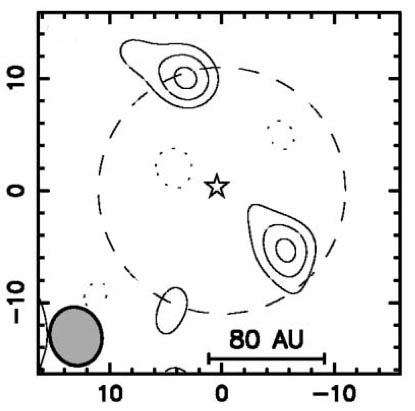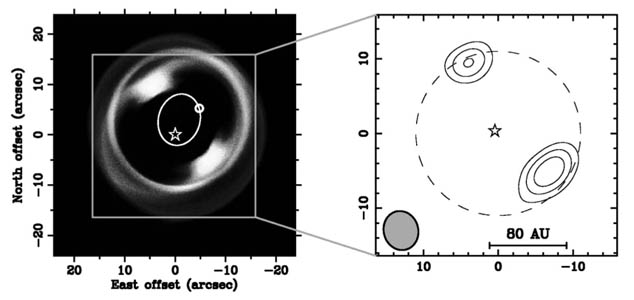
Image credit: Wilner, D. J., Holman, M. J., Kuchner, M. J. and Ho, P. T. P. "Structure in the dusty debris around Vega", 2002, The Astrophysical Journal, Vol. 569, pg. L115-L119
Copyright, please do not reproduce without permission from the authors.
Vega at 1.3 mm
HD 172167 HR 7001
alfa Lyra HIP 91262
RA (2000) = 18 36 56.3364
Dec (2000) = +38 47 01.291
SpT = A0V
V = 0.03 mag d = 7.756 pc
Proper Motion (mas/yr) = +201.03 +287.47
This image of Vega traces thermal
emission of dust at 1.3 mm. The astronomers used the IRAM
Plateau de Bure interferometer with angular resolution 2.5 arcseconds,
corresponding to 20 AU. Contours trace intensity levels, and
the peak contour to the NW (upper left) is displaced from the
star by 9.5 arcseconds, which is also observed in the 850 micron
map of Vega. However, these 1.3 mm data also show an emission peak
8.0 arcseconds to the southwest of the star (lower right).
The plot axes designate arcseconds angular distance away from
the star, where 1 arcsecond = 7.8 AU.
Vega is the brightest star in the Northern Hemisphere
and in 1983 was the first nearby star
observed to possess orbiting solid material.
Researchers using data from IRAS (Infrared
Astronomical Satellite) deduced that the dust
was in a ring approximately 80 AU from
the star with grains larger than 10 microns in
diameter.
The figure above represents a model by Wilner et al. (2002) demonstrating how a planet may
perturb particles in a dust disk, resulting in a structure
that resembles that of Vega. In the image to the left, the planet's
orbit is traced as an ellipse with semimajor axis 40 AU and eccentricity=0.6.
The planet is assumed to have a mass three times that of Jupiter.
The resulting particle distribution shows two clumps that are not
equidistant from the star. On the right, the authors model the resulting
emission contours at 1.3 mm, which match those of the observations.

Basic facts about Vega:
1) age is estimated to be between 310 Myr and 390 Myr
2) structure is a ring with inner and outer radii of 80 and 120 AU, respectively.
3) characteristic grain size is 70 microns, with characteristic temperature 80 K.
4) total dust mass estimates between 0.2-0.7 lunar mass,
i.e. (1.5-5.1)x10^25 g or (7.5-26)x10^-9 M_sun
5) morphology is significantly asymmetric
6) ring is seen near face-on from our point of view. This
orientation is also
derived from Vega's low projected rotational velocity of 22 km/s.